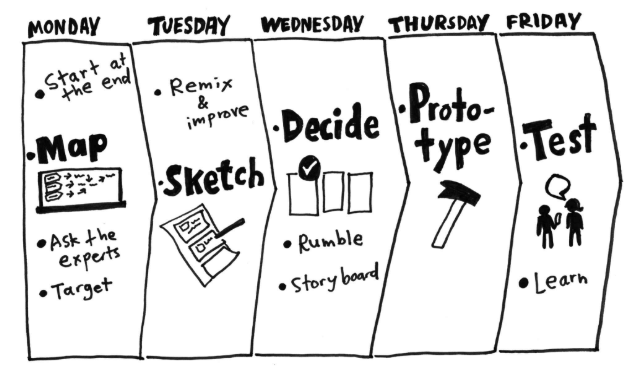Design Sprint

Our team engaged in a Design Sprint recently. It’s the third one that our team has done and the second one that I’ve been involved in. I have to say, Design Sprints are one of the more fun things that I get to participate in as a facilitator.
What’s a Design Sprint?
If you’re not familiar with a Design Sprint, it’s a weeklong series of activities that takes a group of people from an initial idea or problem to a prototyped solution (or solutions) that have been tested by users. It’s a really powerful tool for solving big design problems quickly and getting feedback on your proposed solution.
Each day of the sprint incorporates a group of activities around a specific goal and milestone.
Monday
Monday is all about framing. You frame the big problem that you’re trying to solve and identify challenges that you expect to run into. You make a map of customers and their journey to your end goal. You conduct a series of expert interviews to identify things that you missed. You identify smaller problem that you’d like to solve. Finally, you pick a target to focus on from all of that data.
Tuesday
Tuesday is all about coming up with a wide variety of solutions. I wanted to say that it’s all about brainstorming just for the sake of brevity, but it’s so much more than that. You spend time looking at great solutions that are already in existence, you spend a good chunk of the afternoon sketching a variety of ideas, with each person honing in on a single solution by the end of the day.
Wednesday
Wednesday is a day of decision making. You take the various solutions that you produced on Wednesday, separate the best from the “maybe-laters.” You decide if your best solutions can fit into one prototype, or if you need to develop multiples. Once you have the decisions made, you put together a storyboard that will feed into Thursday’s protyping session.
Thursday
Thursday you prototype. In order to complete a prototype in less than a day, the sprint takes a pretty unique approach. Each person has a specific role in the process. Some people develop new assets. Some people look for existing assets. Someone develops content. And one person assembles it all. There’s also one person who develops the testing script for Friday. At the end of the day, you do a practice run of the user test to see what you missed, leaving just enough time to make corrections.
Friday
Friday is the day it all pays off. Friday you test your prototype with real users. The sprint gives you specific note taking techniques for those observing. It allows you to rapidly collect a lot of information in a way that it’s easy to compare from one test to the other. At the end of the day, you look at all those notes and draw conclusions. By this point, you know if your design works or not, and what you can improve on it.
My Take
There’s no question in my mind as to whether or not the Design Sprint is a valuable use of time. It is. It gives you a working prototype, complete with user feedback in only a week. That’s about as lean as you can get in the design world.
As a facilitator, coach, and trainer, I have a unique appreciation for the activities and the process involved. The Design Sprint embodies the agile value of “individuals and interactions over processes and tools.” There is certainly a defined process to the sprint. But that sprint is a process that is based on, facilitates, and supports the interactions between individuals. There are very few tools that are specifically recommended, and most of the ones that are recommended are easily substituted by something if you find something that you think would work better.
If you’re wanting to try running a Design Sprint of your own, I have a couple suggestions that I think will help:
- Get the physical copy of the book. I initially bought the Kindle version thinking that it would be great to reference it wherever I happened to be. But I found myself wanting to flip back and forth in a way that a digital book doesn’t support very well.
- Get a facilitator who doesn’t participate in the activities. The Design Sprint touches on a wide variety of subjects. It’s very difficult to get off on tangents, lost down rabbit holes, stuck on a difficult decision, or any combination of those. Having someone whose sole job is to monitor the process and keep the group on track is invaluable.
- Stick to the long-term-goal that you established on Monday. If you’re the facilitator, reference it all the time. Since you’re solving a big problem, it’s really easy to let other goals slip in, or veer off course completely.
If you have a big design problem that you need to solve, I definitely recommend giving a Design Sprint a shot. It’s a fun and engaging way to solve the problem and, even though it’s a big commitment, it saves a lot of time in the long run since you don’t have to actually do the development work to validate your prototypes.
